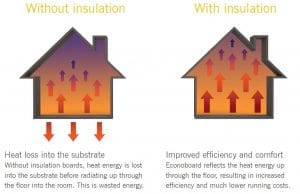What is Insulation and do I need it?
Insulation acts as a barrier to heat flow and is essential for keeping your home warm in winter and cool in summer. A well-insulated and well-designed home provides year-round comfort, cutting cooling and heating bills by up to half.
Did you know that trapped air which cannot move is the best insulator? That’s why birds puff up their feathers to enable them to trap air between their feathers and keep them warm. In the same way Econoboard insulation boards trap air creating an active barrier against heat going down into your substrate and therefore pushing it back up into the room where it is needed.
We all know that hot air rises, however heat travels equally in every direction meaning when using underfloor heating in your home as much heat is lost downwards as comes up through your floor finish unless you insulate beneath the floor heating to stop the downward heat loss. In addition, a layer of insulation stops cold coming up from the substrate and allows your heating system to be more efficient and responsive. A layer of Econoboard insulation will reduce running costs by up to 50% and will mean your floor heats at least 40% faster than without insulation.

So how do I tell if I need insulation under my floor heating system?
All floor heating systems, no matter the brand or type, will be more efficient and benefit from having a layer of insulation between the substrate and the heating.
Which insulation is right for my floor?
The best insulation to use in your application depends on the area of the home this is being installed into (wet area or living area) and the substrate it will be installed onto (concrete slab or timber subfloor).
- In all bathrooms and wet areas we recommend the use of our Coated Econoboard as the Uncoated boards are not suitable for waterproofing. When installing onto a concrete substrate, the Coated Econoboard can be glued down using a bed of flexible tile adhesive, and the waterproofing can be done either beneath this or directly on top of the board, before the underfloor heating is laid. When installing onto a timber subfloor, the Coated Econoboard will need to be screwed down and the waterproofing should be done on top of the boards so that it is not compromised when screwing.
- In all other areas of the home, if you have a concrete substrate the Uncoated Econoboard can be used, and this can be fixed down with a full bed of flexible tile adhesive. If you have a timber subfloor or a floor on bearers and joists, the Coated Econoboard will need to be used so that this can be screwed down using screws and washers.
- When using Thermofoil heating under a floating timber floor use Econosoft Underlay insulation boards loose laid over the substrate.
- With carpeted floors the heating is laid over the underlay and you need to ask the floor layer for an underlay with a high tog rating to help insulate the floor.
- Always use the thickest insulation you can allow for in your height build up for maximum insulation. The Econoboard boards come in 6mm and 10mm thicknesses and are moisture resistant and rot proof.
Econoboard insulation boards are the best way to boost the efficiency and reduce the heat up times of an electric underfloor heating system.
For more information on Econoboard insulation options click here
